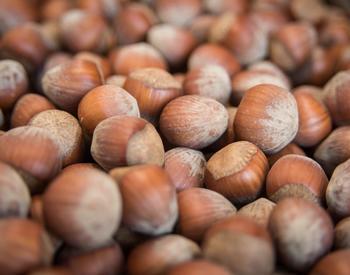Extension faculty jump into action as Eastern Filbert Blight returns
CORVALLIS, Ore. – Nik Wiman thinks about things in the big picture.
Wiman, an orchard crop specialist with the Oregon State University College of Agricultural Sciences and Extension Service, said that this is what brought him to the specialty in the first place. “Orchards are really interesting agricultural systems because they're somewhat permanent.”
Unlike annual crops, Wiman explained, “where you kind of start from zero every year, with an orchard you have the opportunity to do things that really affect the next season and beyond.”
“It gives you a long-term way of thinking for managing pests and diseases,” he said.
This mindset has proved beneficial in the recent months as Oregon hazelnuts face one of these long-term problems: reemergence of the Eastern Filbert Blight, a disease caused by a fungus that targets the tree at the center Oregon’s hazelnut industry — 99% of which sits in the Willamette Valley. The disease mutating to surpass the defenses of a hazelnut tree specifically bred for resistance is the latest iteration in Oregon State’s now 50-year history battle with the disease.
While the blight’s reemergence is nothing to take lightly, Oregon State faculty have 50 years of research and experience to draw from. Jay Pscheidt, the statewide Extension plant pathology specialist, has been working with the disease since he arrived in the 1980s. Armed with “information we didn't have back in the early days,” Pscheidt said, OSU is working with growers to “implement [evidence-based] management techniques.”
How the blight works
What makes the blight tricky is its ghost-like nature. It creeps up on growers.
“Generally, you don't see it right away,” said Pscheidt. “The infection occurs in young buds and then it slowly works its way into twigs and branches. You don't see anything, that first summer. You don't see anything till the next summer.”
Then, Pscheidt explained, “the leaves begin to turn dark. They're stunted. They start falling off.” Next, “You start getting these little bumps that are in a row along the branches.” These bumps turn into to the tell-tale sign: the infamous canker.
Being infected by Eastern Filbert Blight doesn’t lead to the immediate loss of the tree, but since the blight comes back year after year the damage has been done. “After seven years, the trees are not doing very well. They’re not quite dead but might as well be for commercial production,” Pscheidt said.
Despite the slow emergence on the trees, the blight has already spread beyond the orchard. By the second year, it’s producing spores — “you’re talking hundreds of thousands of spores” said Pscheidt — that have drifted onto other trees, and other orchards.
Past battles
Just understanding the lifecycle of the disease took several years of research. “Researchers couldn't make heads or tails of the data in the 1970s, trying to figure out what on earth was going on here,” Pscheidt said. With each experiment the scientists began to unravel the mystery of the disease.
The first “aha moment” was uncovering the disease had a two-year life cycle rather than an annual one. The next was discovering — with the help of five legislatively funded hires to conduct research — when the infection occurred. This information helped growers identify the blight in their orchards.
Pscheidt was the mastermind behind an instrumental management breakthrough: finding the right chemical treatment to manage the fungus. This treatment kept the industry going, while OSU chipped away at the biggest breakthrough of them all: creating a disease-resistant line of hazelnut trees.
The 16-year process of breeding the resistant tree meant that “our tactics for dealing with the disease was management to keep the industry alive until such time as the breeders were ready.”
“It was a lot of research and a lot of people,” Pscheidt said. It paid off though. Hazelnut orchards in Oregon have grown from 28,000 acres to 93,000 acres, into a $100 million industry. “We have a lot of new growers,” Pscheidt said.
Facing the new threat
When an experienced grower shared concerns about widespread blight in an orchard of resistant trees, Wiman held off any assumptions about the disease gaining resistance to the cultivar. Mutation is a real possibility — if not inevitability — with disease-resistant plants. That many acres “puts a huge amount of pressure on that one little gene,” explained Pscheidt. But, as Wiman said, they also had to confirm it was not a new strain of the blight imported from the East Coast.
“As a scientist, we always need to think about ways that we may be deceiving ourselves into making false conclusions about things.” Wiman said.
First, OSU validated that the trees showing blight symptoms were Jefferson, a highly resistant variety released by OSU in 2009. That’s when Wiman consulted Ken Johnson, an OSU professor and plant pathologist who performed some of the initial research on EFB in the 1980s. Johnson and a graduate student determined that EFB had infected the resistant variety.
Once the situation was confirmed, it cast a pall over the industry. “I had to break all this bad news to the growers,” Wiman said. Joining OSU in 2012, Wiman had not been involved in the previous iterations of blight research, but he has close connections with the current growers and knew the stakes.
“It was already a bad time with prices were at historic lows. It was a bad blow,” he said.
To go forward Wiman and Pscheidt had to look back, harnessing the management techniques used before the cultivar was in play. Despite this long-term view, they knew that immediate action was necessary. “We had to get the word out right away,” said Wiman. Wiman quickly developed a factsheet about the blight, alongside informational cards to aid in identifying it. All materials were made available in English and in Spanish.
Plus, they jumped into making sure informational guides published by Extension were usable. “We started working with OSU Extension Communications to make sure all our references are up to date and modernized,” Wiman said.
Wiman and Pscheidt also co-hosted multiple informational events this past winter to get growers up to speed with developments that drew hundreds of growers. “The new strain of Eastern Filbert Blight has some distinctive symptoms on the new varieties,” said Wiman.
'A very positive outlook'
But Pscheidt emphasized that the growers who were around in the first wave of the blight “have a very positive outlook.” Everyone is working to teach the newer growers the tried-and-true management techniques that Extension developed in the past.
Some of that includes spraying, which isn’t popular. “Growers don't like spraying fungicides, no one likes to see it,” said Pscheidt.
“I don't want to tell people to spray more. I want to tell people to spray less and to make our industry as sustainable as possible,” said Wiman.
But Wiman and Pscheidt note that past research has helped them fine-tune the fungicide use, potentially reducing the need for repeated sprays in spring.
While sharing previous research and management techniques is vital, the team is also is launching back into research. Climate change is a new variable. “This is a wet weather pathogen” said Pscheidt. “If we start having heavy rains, we might see quite an explosion of this. Or it could be really dry. You could go either direction, depending on what the weather's going to do.”
And, of course, the OSU hazelnut breeding program is at it again, program continues to push forward, working to release new cultivars. “New varieties are going to come out of the breeding program with much stronger resistance,” said Wiman, “We will transition to those varieties.”

 Extension Service
Extension Service
